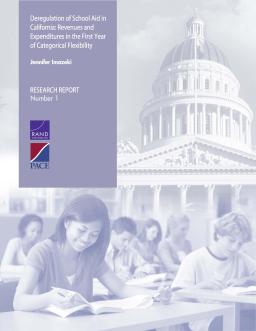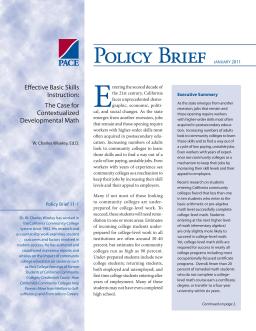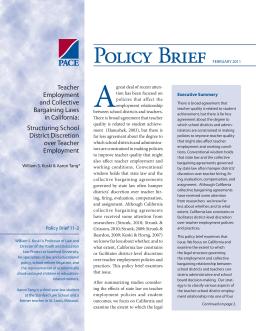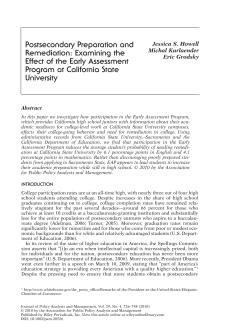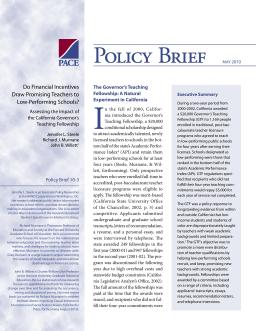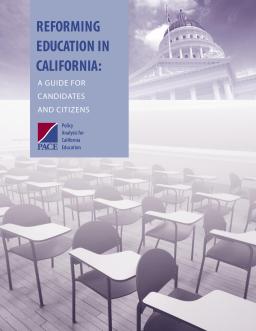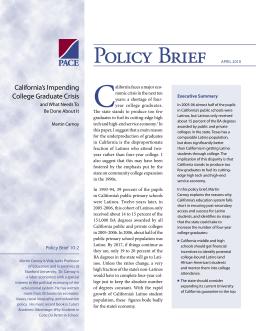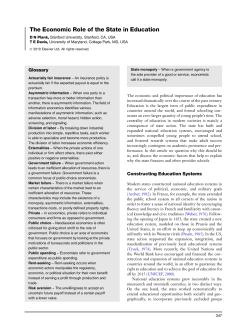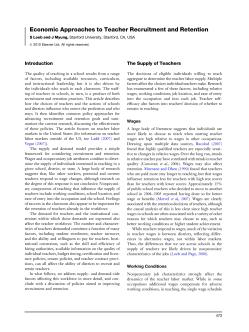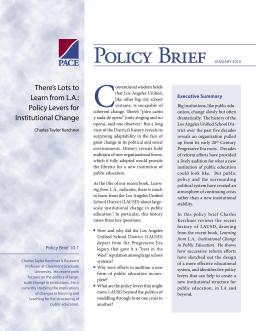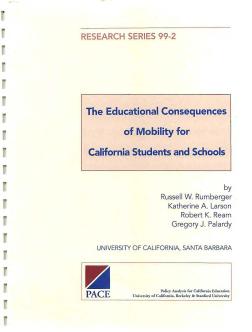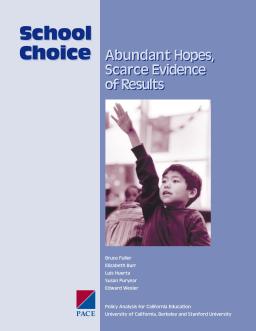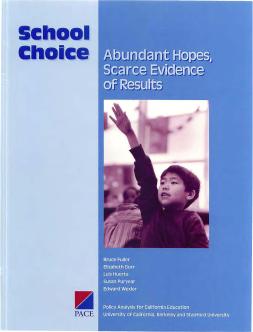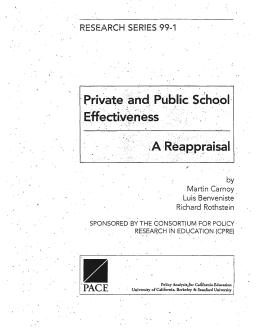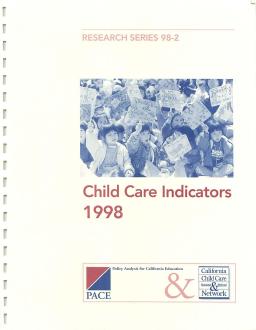Published
Summary
This report provides policy guidance for new state assessments aligned to Common Core State Standards. It aims to inform the work of the two consortia funded by the U.S. Department of Education in developing the assessments. The report includes three papers addressing issues of computer adaptive assessments, assessment of English learners, and assessing science. The authors' vision of new assessments goes beyond the horizon of current practice and emphasizes the need to use new technologies to provide useful and timely information to students and teachers.
How 10 Districts Responded to Fiscal Flexibility, 2009–2010
Published
Summary
This report explores how 10 California school districts responded to the deregulation of $4.5 billion in education funding, which became entirely flexible in 2009. The study investigates how district leaders made budget decisions and what local factors influenced their responses. The research was conducted by a team of scholars from the RAND Corporation, UC Berkeley, UC Davis, and San Diego State University.
Revenues and Expenditure in the First Year of Categorical Flexibility
Published
Summary
This report discusses the effects of California's partial release of categorical funds to local school boards in 2009. The increased flexibility has provided an opportunity to observe how districts respond to the policy change, but the impact is difficult to isolate as most districts have been struggling to maintain core services during a severe budget crisis. The report includes preliminary results from an ongoing study of district responses to the increased categorical flexibility.
The Case for Contextualized Developmental Math
Published
Summary
This brief analyzes the effectiveness of contextualized developmental math in California Community Colleges, where fewer than 10% of students who enter at the basic math level complete college-level math. These integrated courses focus on math required in specific occupations and have higher success rates than traditional math courses. However, the pressure for traditional academic courses has eliminated many of these courses, hindering students' ability to acquire occupational skills and complete advanced courses or degrees.
Structuring School District Discretion over Teacher Employment
Published
Summary
This brief analyzes the relationship between teacher employment, collective bargaining laws, and school district policies in California. The authors examine the extent to which California's legal structure constrains or facilitates district-level discretion over teacher employment policies and practices. They classify various aspects of the teacher-school district employment relationship into four categories, and conclude that California statutory law is somewhat more constraining of administrative decision-making in teacher employment matters than in four other large and diverse states.
Published
Summary
The James Irvine Foundation sponsors the Linked Learning approach as a strategy for improving California high schools' performance. PACE was asked to gather evidence on the cost of linked learning programs. The report explores how traditional high schools use their resources and how much school districts spend on their high schools to achieve current performance. It proves challenging to judge whether reform strategies like Linked Learning cost more than, less than, or the same as traditional high school programs.
Clearing Away the Smoke and Mirrors
Published
Summary
This brief examines the strengths and weaknesses of value-added measures, which are useful for separating out school influences from other factors when evaluating teacher and school performance. Although value-added assessments give a summative picture of teacher performance, they do not provide guidance on how to improve. The author explores best uses and practices for value-added measures and discusses the limitations of attainment measures in evaluating school performance. The "Cardinal Rule of Accountability" is to hold people accountable for what they can control.
Examining the Effect of the Early Assessment Program at California State University
Published
Summary
This study analyzes the impact of the Early Assessment Program (EAP) on the college-going behavior and remediation needs of California high school juniors. Results show that EAP participation reduces the need for remediation at California State Universities by 6.1 percentage points in English and 4.1 percentage points in mathematics. The program does not discourage poorly prepared students from applying to college but rather encourages them to increase their academic preparation in high school.
California’s Quality Education Investment Act
Published
Summary
This working paper examines the use of Quality Education Investment Act (QEIA) funds, which allocated $2.6B over seven years to California's lowest-performing schools. The authors conducted a study of four Los Angeles high schools to investigate how QEIA dollars were spent in the first year, who made the decisions, and how funds were used to improve teaching and the instructional program. The study found that district officials and principals had discretion in allocating funds, consistent with recent efforts to deregulate categorical-aid programs and give local educators fiscal discretion.
Assessing the Impact of the California Governor’s Teaching Fellowship
Published
Summary
This brief evaluates the effectiveness of CA's Governor's Teaching Fellowship, which aimed to recruit and retain highly qualified teachers in low-performing schools by providing a $20K fellowship to individuals enrolled in traditional teacher licensure programs who agreed to teach in designated schools. The study found that financial incentives can attract skilled professionals to work with underserved populations, but alternative policy designs should also be explored for cost-effectiveness. The results of the evaluation have important implications for state and national education policy.
A Guide for Citizens and Candidates
Published
Summary
PACE has published a policy book to support informed debates about the issues facing California education. The book includes recommendations to improve education quality, targeting resources to those who need it most, giving local schools more flexibility, and designing policies for continuous improvement. While there's no one solution to fix public education, a series of good policies can bring about fundamental reform and improve outcomes for schools and students.
Published
Summary
This brief discusses the significant disparity between the Latino population in California's public schools and their representation among college graduates. The author suggests that this may lead to a shortage of graduates for California's economy and outlines six steps the state could take to improve access and success for Latino students in higher education.
Published
Summary
This article explores the reasons why education has become a central focus of modern societies and the largest public expenditure around the world. The state has built and expanded national education systems, made attending school mandatory, and linked adult success to academic performance. The article delves into the economic factors behind state financing and provision of schools.
Published
Summary
This article discusses how teacher recruitment and retention affect the quality of teaching in schools. The supply and demand model, including wages and non-pecuniary job attributes, influences the supply of potential and current teachers. The demand for teachers depends on factors such as student enrollment and institutional constraints such as hiring authorities' skill and efficiency. The article identifies common policy approaches to improve recruitment and retention and summarizes current research on their effectiveness.
Policy Levers for Institutional Change
Published
Summary
The Los Angeles Unified School District has undergone decades of reform, resulting in an unstable atmosphere rather than institutional stability. A recent book, "Learning from L.A.: Institutional Change in Public Education," identifies five policy levers that can create a more effective educational system and a new institutional structure for public education, both in LA and beyond.
Published
Summary
Policymakers aim to improve student outcomes through the hiring of highly qualified teachers, but there is little consensus on what qualities make a teacher "good." Research on teacher characteristics that impact student achievement is inconclusive. This article examines recent empirical evidence on teacher quality in education production.
Published
Summary
Economics of education has grown in importance over the past two decades, as education is viewed as a critical factor in a nation's economic success. Economics can help improve the productivity of educational institutions by focusing on incentives, choice, and competition. The article reviews important theoretical concepts in the economics of education, including human capital, markets, and education production, and how they have been used in empirical studies.
Published
Summary
This study examines student mobility in California, particularly at the secondary level. It investigates the incidence, consequences, and causes of non-promotional school changes and offers strategies to address the issue. It also draws on an extensive dataset from various sources, including surveys and interviews with California students, parents, and schools. The findings highlight the negative impact of student mobility on educational achievement and suggest that families, schools, community agencies, and policymakers should take action to mitigate its harmful effects.
Published
Summary
Student mobility, or non-promotional school changes, is a widespread problem that harms students' educational achievement. This report examines the incidence, consequences, and causes of mobility among California students and schools, drawing on surveys of students, parents, and schools, interviews with mobile students and their parents, and interviews with school administrators, counselors, and teachers. The report summarizes the findings on the causes and consequences of mobility and offers strategies for reducing needless mobility and mitigating its harmful effects.
Published
Summary
Spring 1999 PACE Newsletter, Volume 2, Number 1.
Abundant Hopes, Scarce Evidence of Results—Executive Summary
Published
Summary
Public education in the US is widely criticized and everyone wants to reform it, but there's no consensus on the best strategy for improvement. This report focuses on school choice, a reform avenue gaining steam in California and the US, to explore policies and institutional changes that can boost children's learning.
Published
Summary
The report provides local and state-level policymakers with data on the current capacity of the childcare system and indicators of future growth in family demand. It includes county-level aggregates, new data on job-related income, and estimates for families earning less than 75% of California's median income. It also adds new data on the size of the childcare workforce in each county, revealing disparities in the availability of childcare services and the number of local residents depending on the industry for their livelihood.
Abundant Hopes, Scarce Evidence of Results
Published
Summary
Public education receives criticism from various stakeholders. Despite satisfaction with local elementary schools, overall quality concerns prevail. There is no consensus on the best approach to improve schools. PACE report investigates school choice, which is a reform strategy gaining popularity in California and beyond.
A Reappraisal
Published
Summary
This report challenges the belief that public schools are ineffective due to a lack of accountability for producing high academic achievement. Some argue that private management is necessary for improvement, but this report seeks to analyze the range of responses that schools have to accountability and determine whether market forces are necessary for improvement.
Preliminary Figures
Published
Summary
California's childcare system lacks planning capacity and data on supply and demand. The Child Care Indicators 1998 report provides early indicators of supply and demand for all zip codes statewide, but zip codes may not reflect local residents' own definition of their community. Public funding for childcare and preschool programs will double in California between 1996 and 1999, but targeting new funding to areas with the greatest need remains a challenge.


